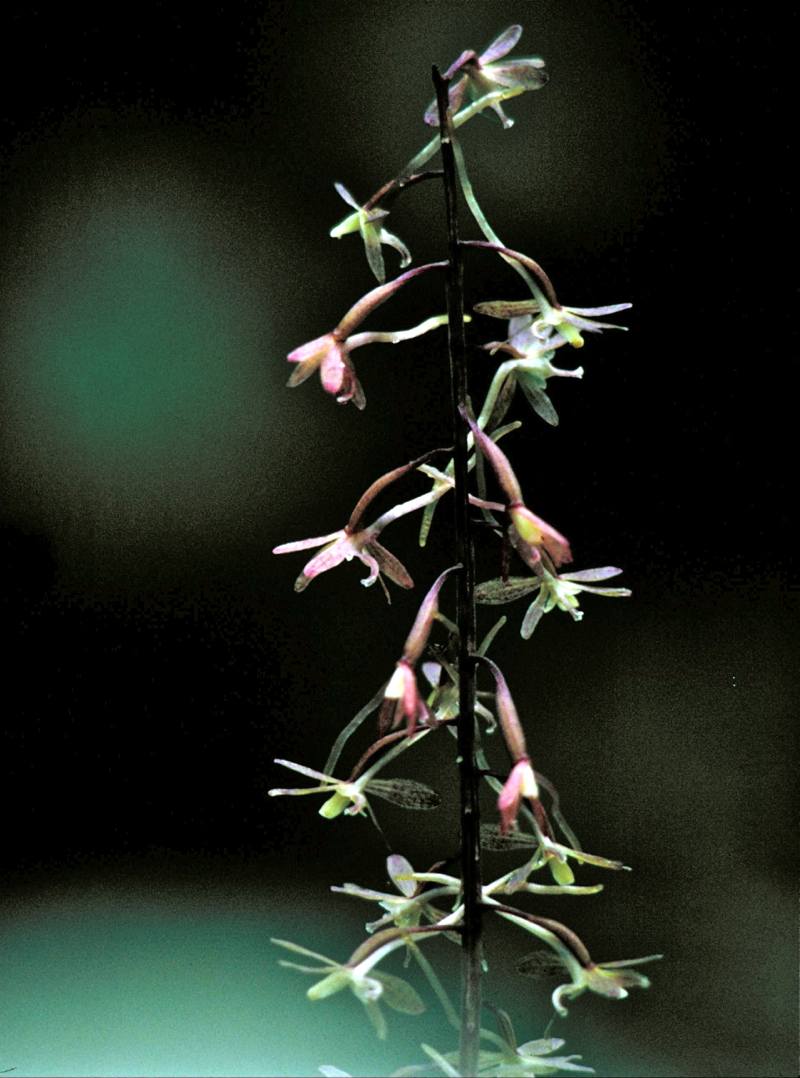Crane-fly Orchid in the Woodlands
 Thursday, January 26, 2012 at 5:10PM
Thursday, January 26, 2012 at 5:10PM For years I have noticed some distinctive corrugated leaves which push up in the woodlands in the fall and persist through the winter and into spring, then vanishing by summer. The leaves are blue-green on top and a rich wine color underneath:These lovely Crane-fly Orchid leaves are growing in the Woodland Garden.It's a wild plant, but definitely not weedy. I had no idea what it was; even after searching through garden books I could not find anything like it.
Then yesterday while browsing the internet (Do you remember the world before the internet?) I came across a photo of my wildflower, and I finally had an identification: Tiliparia discolor, also known as Crippled Crane-fly or Crane-fly orchid.
I have orchids growing in my woodlands!
You may have some type of native orchid growing near you, too. The orchid family is huge, with almost thirty-thousand naturally occurring species of orchids growing worldwide. There are also over a hundred thousand man-made orchid species! The family is extremely diverse. Orchids may be tiny wildflowers, or they may be showy prize-winners grown in hot houses, but they all have a couple of things in common. First, they all have three sepals that form the calyx of the flower. The calyx is the protective layer around the flower in bud. When one looks at a flower bud, one is looking at the calyx. All orchids also have three flower petals. One of the petals is dramatically different from the other two and is called the lip. The lip is the most attractive part of the plant. It draws in pollinators, pointing the way to the central reproductive organ, called the column, which contains both male and female parts.
The Crane-fly orchid is a native plant to the eastern half of the United States, growing from Texas to New York and Massachusetts, hardiness zones 4-10. It grows in the woodland setting and requires mychorrhizal fungus to grow along its roots to survive. The symbiotic relationship is interesting. The fungus gains carbohydrates from the orchid's roots, while the orchid draws water and mineral nutrients from the fungi. This is especially helpful in poor, shallow soils of dry woodlands. In some areas it is a rare or endangered species. Each Crane-fly orchid has a single leaf, which can be either smooth or corrugated, and they tend to grow in clumps. After the leaf dies back in summer, the orchid sends up a single purple stem about one to two feet tall. Each stem has a couple dozen greenish-purple, translucent flowers. This is a public domain photo of a Crane-fly orchid. I hope to make photos of my own this summer!The thin stems and small flowers are easy to miss in the woodland setting, but I think I have seen these! I did not know what I was looking at and did not associate them with the pretty leaves that had disappeared in early summer. Night flying moths don't overlook these flowers, however. They are drawn to the pale flowers and the sweet nectar and are the primary pollinators of this native plant.
This is a public domain photo of a Crane-fly orchid. I hope to make photos of my own this summer!The thin stems and small flowers are easy to miss in the woodland setting, but I think I have seen these! I did not know what I was looking at and did not associate them with the pretty leaves that had disappeared in early summer. Night flying moths don't overlook these flowers, however. They are drawn to the pale flowers and the sweet nectar and are the primary pollinators of this native plant.
Now I am looking forward to the hot, muggy days of late summer, when I will be outside, searching for Crane-fly orchid flowers.
 Permalink
Permalink 
